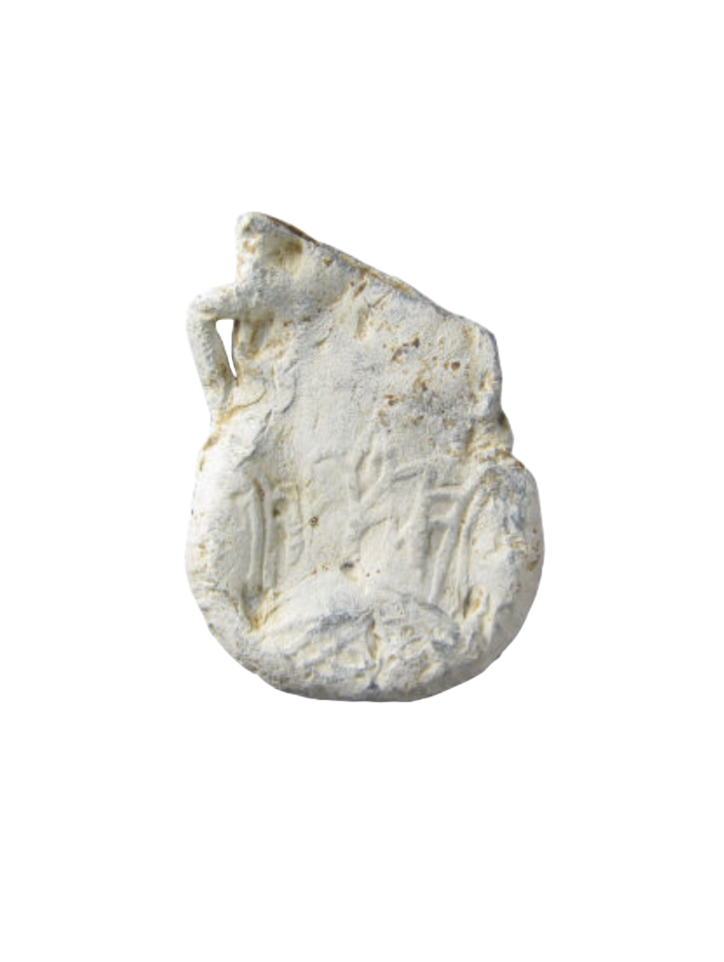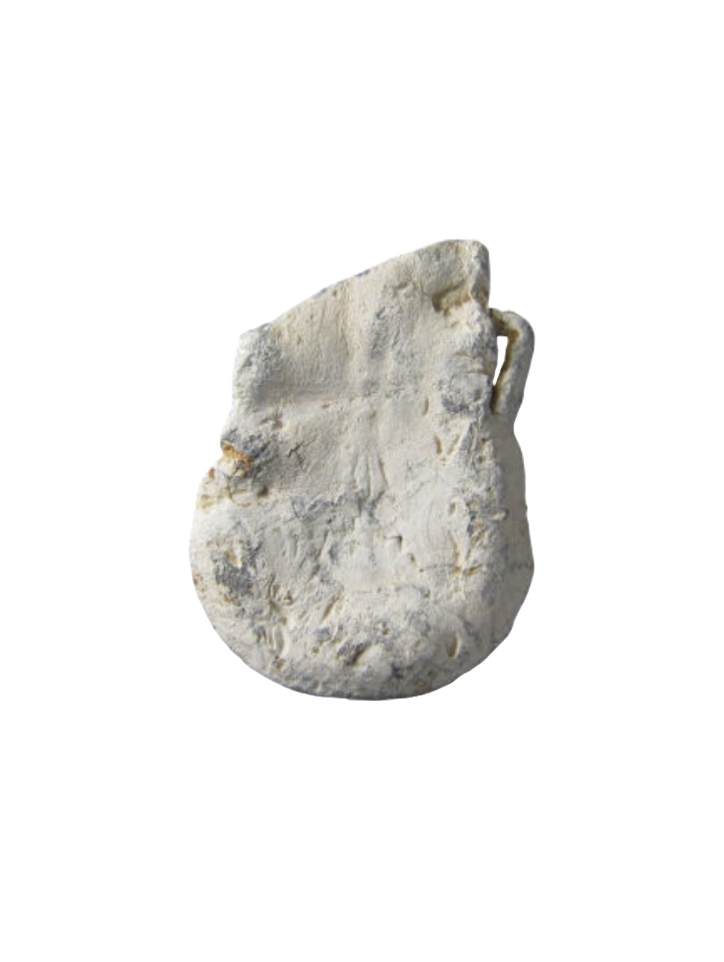 Image 1 of 2
Image 1 of 2

 Image 2 of 2
Image 2 of 2



Medieval Ampulla
This medieval ampulla, made from a lead alloy and dating back to approximately AD 1175-1400, of which the top portion sliced off at an angle, possibly to access the holy water it once contained. Of the original attachment loops, only one remains, characterized by a sharp, angular shape. The flask's body is designed to resemble a scallop shell, though the ribbed pattern is only visible near the base. The central section on both sides features a crown motif with detailed cross-hatching inside. The lead has aged, acquiring a white patina.
This piece is accompanied by a (PAS) British Museum's Portable Antiquities Scheme, report number: SWYOR-0EAB85.
An ampulla is usually a small, typically round or flask-shaped vessel used in ancient and medieval times to hold liquids, particularly holy substances like oil or water. In a religious context, ampullae were often used to contain holy water or consecrated oil for use in sacraments, blessings, or pilgrimages. They were sometimes carried as a form of protection or as a keepsake from a pilgrimage site.
In medieval Europe, ampullae were often made of materials like lead or glass, and they could be decorated with religious symbols, such as crosses, crowns, or images of saints. These vessels were commonly used by pilgrims who would carry them to hold holy water or oil from a shrine or holy site. The designs on the ampullae often reflected the religious significance of their contents and the place from which they were acquired.
This medieval ampulla, made from a lead alloy and dating back to approximately AD 1175-1400, of which the top portion sliced off at an angle, possibly to access the holy water it once contained. Of the original attachment loops, only one remains, characterized by a sharp, angular shape. The flask's body is designed to resemble a scallop shell, though the ribbed pattern is only visible near the base. The central section on both sides features a crown motif with detailed cross-hatching inside. The lead has aged, acquiring a white patina.
This piece is accompanied by a (PAS) British Museum's Portable Antiquities Scheme, report number: SWYOR-0EAB85.
An ampulla is usually a small, typically round or flask-shaped vessel used in ancient and medieval times to hold liquids, particularly holy substances like oil or water. In a religious context, ampullae were often used to contain holy water or consecrated oil for use in sacraments, blessings, or pilgrimages. They were sometimes carried as a form of protection or as a keepsake from a pilgrimage site.
In medieval Europe, ampullae were often made of materials like lead or glass, and they could be decorated with religious symbols, such as crosses, crowns, or images of saints. These vessels were commonly used by pilgrims who would carry them to hold holy water or oil from a shrine or holy site. The designs on the ampullae often reflected the religious significance of their contents and the place from which they were acquired.
This medieval ampulla, made from a lead alloy and dating back to approximately AD 1175-1400, of which the top portion sliced off at an angle, possibly to access the holy water it once contained. Of the original attachment loops, only one remains, characterized by a sharp, angular shape. The flask's body is designed to resemble a scallop shell, though the ribbed pattern is only visible near the base. The central section on both sides features a crown motif with detailed cross-hatching inside. The lead has aged, acquiring a white patina.
This piece is accompanied by a (PAS) British Museum's Portable Antiquities Scheme, report number: SWYOR-0EAB85.
An ampulla is usually a small, typically round or flask-shaped vessel used in ancient and medieval times to hold liquids, particularly holy substances like oil or water. In a religious context, ampullae were often used to contain holy water or consecrated oil for use in sacraments, blessings, or pilgrimages. They were sometimes carried as a form of protection or as a keepsake from a pilgrimage site.
In medieval Europe, ampullae were often made of materials like lead or glass, and they could be decorated with religious symbols, such as crosses, crowns, or images of saints. These vessels were commonly used by pilgrims who would carry them to hold holy water or oil from a shrine or holy site. The designs on the ampullae often reflected the religious significance of their contents and the place from which they were acquired.
Portable Antiquities Scheme (PAS): SWYOR-0EAB85
Length: 45.56 mm
Width: 33.5 mm
Thickness: 7.49 mm
Weight: 34.75 grams
Region found: Yorkshire and the Humber, County: North Yorkshire, District: Harrogate, Parish: Brearton
Found via metal detector
Found by/Provence: Peter Kurton